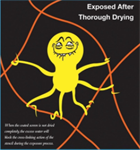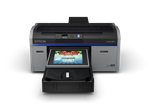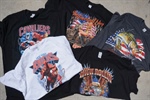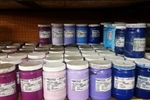
When it comes to emulsions, paying attention to the small details makes a big difference.
Friday, March 16, 2018/Author: Anonym/Number of views (1380)/Comments (0)/
Tags:

From pretreating to drying garments, use these tips to optimize workflow.
Saving time during production is the goal of all garment decorators. That's especially true when it comes to direct-to-garment (DTG) printing, which doesn't have a reputation as the quickest decorating technology.
But in today's world, where customers have "I-want-it-custom," "I-want-one" and "I-want-it-now" mindsets, decorators must come to grips with the realities of short-run production.
The following are a few things you can do to improve your production rate.
Wednesday, March 14, 2018/Author: Anonym/Number of views (1161)/Comments (0)/
Tags:

Last year, online fashion accounted for nearly 20% of retail e-commerce sales in the United States – a total of more than $458 billion. This massive sum of business is changing expectations for apparel customers, who thirst for on-demand personalized garments that can be manufactured in small quantities and delivered at incredible speeds. “Online shopping has turned the idea of supply and demand on its head,” says Omer Kulka, VP of marketing and product strategy for Kornit, which manufactures digital inkjet printers for the apparel decoration industry. “Instead of selling what we’ve already manufactured, we’re being asked to manufacture what we’ve already sold.”
Monday, March 12, 2018/Author: Anonym/Number of views (2128)/Comments (0)/
Tags:

Answers to five questions about direct-to-garment printing quality, production, maintenance and more.
Thursday, March 8, 2018/Author: Anonym/Number of views (1241)/Comments (0)/
Tags:

Whether you’ve been in the decorated apparel game for decades or you’re just starting out, you’ve probably realized that having top-notch equipment is a vital part of your business’ success. From keeping up with the trends to providing the staples customers rely on, your equipment has to keep up. If your current equipment just isn’t enough anymore, it’s time to look into financing your next piece.
Tuesday, March 6, 2018/Author: Anonym/Number of views (1235)/Comments (0)/
Tags:

As we move into 2018, the pretreatment process for D2 printing is still a major requirement. We have seen a lot of development with inks and a wider range of fabric printability combined with newer pretreatment solutions. The actual process of pretreating a garment prior to printing is something that will probably be around for a long time.
Thursday, March 1, 2018/Author: Anonym/Number of views (1252)/Comments (0)/
Tags:

Ghosting—the word that strikes terror and headaches in new and seasoned printers alike. Ghosting occurs when the screen-printing ink reacts to the dyes in the garment. This issue might not be noticeable right away, but before you know it you will find your image repeated on the backs and bottoms of your whole print job. Nothing is more embarrassing than sending a load of shirts home to a customer only to receive that dreaded phone call a day or two later.
Tuesday, February 27, 2018/Author: Anonym/Number of views (2198)/Comments (0)/
Tags:

MagnaColours announces a new initiative entitled “Make the Switch,” aimed at screen printers. The program is designed to help shops transition from plastisol to water-based inks.
Friday, February 23, 2018/Author: Anonym/Number of views (1132)/Comments (0)/
Tags:

Screen printing on fleece is by no means a new process; fleece is only second to T-shirts among garments in terms of printing popularity. This installment of the Impressions Tech Tips Newsletter will feature printing on the American Apparel® Mason Fleece Drop Shoulder Sweatshirt (style HVF496W).
Wednesday, February 21, 2018/Author: Anonym/Number of views (1139)/Comments (0)/
Tags:

If it sounds too good to be true, it usually is. Don’t let the hype fool you. It’s not necessary to pay an excessive amount of money to get a quality product.
When it comes to quality ink, what’s inside the container should speak for itself; otherwise, don’t buy it. Just because someone says their product is better, or just because the packaging or names look modern and hip, the hype is not necessarily true, nor is the product necessarily better.
Friday, February 16, 2018/Author: Anonym/Number of views (1213)/Comments (0)/
Tags: